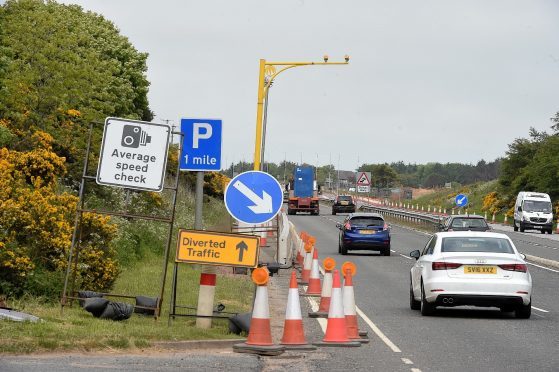Nearly 500 drivers have been clocked by controversial average speed cameras on the north-east’s busiest road.
The cameras were installed on the A90 Aberdeen to Fraserburgh road, between Balmedie and Blackdog, to protect the construction team working on the Aberdeen bypass.
Today the Press and Journal can reveal more than 460 motorists have been caught flouting the 50mph limit – with some culprits doing nearly 90mph.
And last night, Transport Scotland announced more of the cameras are to be installed at the other side of the A90, south of Aberdeen at Charleston.
They are being brought in to protect workers building a new bridge, and work to install them will begin on Monday.
Our exclusive figures show that since July 25, a total of 466 motorists have been caught speeding on the northern stretch of the A90.
Of this, 61 of the offenders were found to be averaging in excess of 70mph – with some possibly reaching as high as 89mph.
A total of 405 motorists were clocked going between 50mph and 69mph.
The A90 is being upgraded between Balmedie and Tipperty as part of the £745million Aberdeen Western Peripheral Route.
Along with the average speed cameras, traffic lights have also been put in place at Balmedie as work to build a flyover is carried out.
In August, a further 50mph restriction was introduced between the Ellon bypass and Murcar roundabouts to further safeguard AWPR workers.
Banffshire and Buchan Coast SNP MSP Stewart Stevenson said those “grossly speeding” between Balmedie and Blackdog were a “danger both to themselves and to other road users”.
“I hope that people take the need to obey the speed limit, which is there for a purpose, very seriously indeed,” he said. “We have seen on the A9 that these cameras have reduced accident levels and that should be equally applicable to the A90.
“The investment in the AWPR is going to improve road safety for the communities of the north-east. It is the case that we are looking for through-traffic to avoid going into Aberdeen at all.”
Mid-Formartine councillor Paul Johnston said he hoped the figures will encourage motorists to slow down.
He added: “You would expect those numbers to drop quickly. The people who are regular speeders will now change their behaviour because they see how easy it is to get caught.
“It’s about changing behaviour, not just punishing people. That’s how you save lives.”
A Transport Scotland spokesman said although the figures showed “around 99.9% of motorists” were complying with the restrictions, it was disappointing to see there were still some willing to risk lives.
He added: “One road user speeding along this road is one road user too many because they are creating a risk to themselves and to road workers. Where a driver is detected as being excessively above the speed limit the circumstances are reported by the camera unit to the procurator fiscal for consideration of the appropriate action.
“It is necessary to ensure the speed restriction at this location is observed at all times to enhance the safety of construction workers and road users.
“In addition to these proven safety benefits, their use in major road works projects demonstrates their ability to improve traffic flow and journey time reliability.
“The average speed cameras are expected to stay in place until the works are complete and the reduced temporary speed limit is removed from this section of the A90.”
Arron Duncan, north safety camera unit manager, added: “Those drivers who make the conscious decision to ignore the speed limit in force will have to accept that they will then have to deal with the consequences through our enforcement measures. In reality it is a short section of road and for their safety and the safety of all others I would appeal to drivers to comply with the 50mph speed limit as the time saved by not doing so is not worth it in any way.
“There is no doubt in my mind that the presence of the average speed camera system on this stretch of road has resulted in the high levels of compliance that are being achieved and this is consistent with other locations throughout the UK where this technology is deployed. The reduction in risk as a result of this compliance cannot be over-estimated.”
